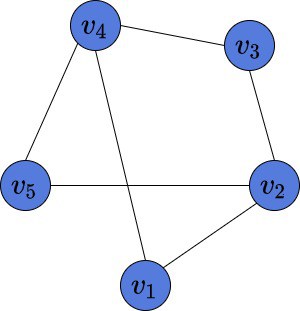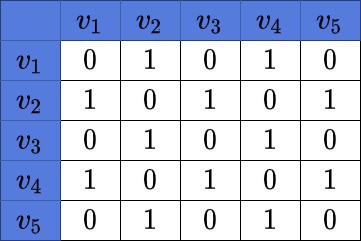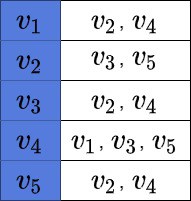1. Overview
In this tutorial, we’ll learn one of the main aspects of Graph Theory — graph representation. The two main methods to store a graph in memory are adjacency matrix and adjacency list representation. These methods have different time and space complexities.
Thus, to optimize any graph algorithm, we should know which graph representation to choose. The choice depends on the particular graph problem. In this article, we’ll use Big-O notation to describe the time and space complexity of methods that represent a graph.
2. Graph Representation
It’s important to remember that the graph is a set of vertices that are connected by edges
. An edge is a pair of vertices
, where
. Each edge has its starting and ending vertices. If graph is undirected,
. But, in directed graph the order of starting and ending vertices matters and
.
Here is an example of an undirected graph, which we’ll use in further examples:

This graph consists of 5 vertices , which are connected by 6 edges
, and
.
Some graphs might have many vertices, but few edges. These ones are called sparse. On the other hand, the ones with many edges are called dense. Our graph is neither sparse nor dense. However, in this article, we’ll see that the graph structure is relevant for choosing the way to represent it in memory.
3. Adjacency Matrix
The first way to represent a graph in a computer’s memory is to build an adjacency matrix. Assume our graph consists of vertices numbered from
to
. An adjacency matrix is a binary matrix of size
. There are two possible values in each cell of the matrix: 0 and 1. Suppose there exists an edge between vertices
and
. It means, that the value in the
row and
column of such matrix is equal to 1. Importantly, if the graph is undirected then the matrix is symmetric.
3.1. Example
Here is an example of an adjacency matrix, corresponding to the above graph:

We may notice the symmetry of the matrix. Also, we can see, there are 6 edges in the matrix. It means, there are 12 cells in its adjacency matrix with a value of 1.
3.2. Time and Space Complexity
Assuming the graph has vertices, the time complexity to build such a matrix is
. The space complexity is also
. Given a graph, to build the adjacency matrix, we need to create a square
matrix and fill its values with 0 and 1. It costs us
space.
To fill every value of the matrix we need to check if there is an edge between every pair of vertices. The amount of such pairs of
given vertices is
. That is why the time complexity of building the matrix is
.
3.3. Pros and Cons
The advantage of such representation is that we can check in time if there exists edge
by simply checking the value at
row and
column of our matrix.
However, this approach has one big disadvantage. We need space in the only case — if our graph is complete and has all
edges. The matrix will be full of ones except the main diagonal, where all the values will be equal to zero. But, the complete graphs rarely happens in real-life problems. So, if the target graph would contain many vertices and few edges, then representing it with the adjacency matrix is inefficient.
4. Adjacency List
The other way to represent a graph in memory is by building the adjacent list. If the graph consists of vertices, then the list
contains
elements. Each element
is also a list and contains all the vertices, adjacent to the current vertex
. By choosing an adjacency list as a way to store the graph in memory, this may save us space.
For instance, in the Depth-First Search algorithm, there is no need to store the adjacency matrix. At each algorithm step, we need to know all the vertices adjacent to the current one. This what the adjacency lists can provide us easily. We may also use the adjacency matrix in this algorithm, but there is no need to do it. Instead, we are saving space by choosing the adjacency list.
4.1. Example
This is the adjacency list of the graph above:

We may notice, that this graph representation contains only the information about the edges, which are present in the graph.
4.2. Time and Space Complexity
If is the number of edges in a graph, then the time complexity of building such a list is
. The space complexity is
. But, in the worst case of a complete graph, which contains
edges, the time and space complexities reduce to
.
4.3. Pros and Cons
As it was mentioned, complete graphs are rarely meet. Thus, this representation is more efficient if space matters. Moreover, we may notice, that the amount of edges doesn’t play any role in the space complexity of the adjacency matrix, which is fixed. But, the fewer edges we have in our graph the less space it takes to build an adjacency list.
However, there is a major disadvantage of representing the graph with the adjacency list. The access time to check whether edge is present is constant in adjacency matrix, but is linear in adjacency list. In a complete graph with
vertices, for every vertex
the element of
would contain
element, as every vertex is connected with every other vertex in such a graph.
Therefore, the time complexity checking the presence of an edge in the adjacency list is . Let’s assume that an algorithm often requires checking the presence of an arbitrary edge in a graph. Also, time matters to us. Here, using an adjacency list would be inefficient.
5. Removing Edges and Vertices
Let’s now see the worst-case complexity of removing a vertex and an edge.
5.1. Removing a Vertex
Let’s suppose we want to remove .
If we use the adjacency matrix, we’ll have to set all the entries in the -th row and the
-th column to zero. Doing so will delete all the edges incident to
, effectively removing
from the graph. In total, we’ll iterate over
cells, so the time complexity will be
.
On the other hand, removing a vertex from an adjacency list will cost more. To remove all the outgoing edges, we set to NULL the pointer to the ‘s list,
. However, to delete all the occurrences of
from other nodes’ lists, we have to iterate over all the other lists. In the worst case, each node will be connected to all the other vertices, so we’ll traverse
list elements. Therefore, removing a vertex from the list representation of a graph is an
operation.
5.2. Removing an Edge
To remove an edge from an adjacency matrix
, we set
to zero. If the graph is symmetric, we do the same with
. Accessing a cell in the matrix is an
operation, so the complexity is
in the best-case, average-case, and worst-case scenarios.
If we store the graph as an adjacency list, the complexity of deleting an edge is . That’s because, in the worst case, we traverse the whole list
to remove
from it. If the graph is symmetric, we do the same with
, removing
from it. In total, we iterate over no more than
elements, so the complexity is
.
6. Conclusion
In this tutorial, we’ve discussed the two main methods of graph representation. We’ve learned about the time and space complexities of both methods. Moreover, we’ve shown the advantages and disadvantages of both methods.
The choice of the graph representation depends on the given graph and given problem. In some problems space matters, however, in others not. These assumptions help to choose the proper variant of graph representation for particular problems.